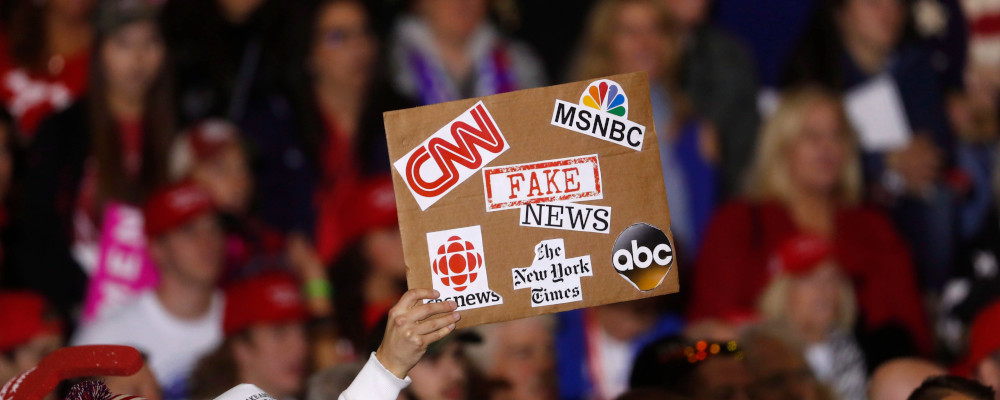The news media in Canada is in crisis. Policy responses to date are failing to solve for the information that citizens need to make informed decisions about important issues and debates. The Future of News series brings together leading practitioners, scholars, and thinkers to imagine new business models, policy responses, and journalistic content that can support a dynamic future for news in Canada.
Trust in media is low these days. So low, in fact, that leadership has been forced to contemplate why. And the reasons that Canadian media executives come up with are manifold. The problem is an overall decline in trust in public institutions. Or it’s fractured attention online. Or news fatigue and avoidance. Or misinformation and disinformation. Or political polarization, populism, politicians antagonizing the press. Or else, it’s social media. It’s Big Tech’s fault.
But it’s really not that complicated. The problem is us.
As reporter Matt Taibbi said at the 2022 Munk Debate, “When you’re a journalist and people don’t trust you, it’s always your fault.”
The media has been busy blaming everyone but the media itself. But in the meantime, the public has been sending us a clear message: they don’t trust us because they think we’re biased. When I left the CBC, citing a lack of viewpoint diversity, I received a deluge of comments from the public. Overwhelmingly, people told me that they’d lost faith in the media because we no longer seemed politically neutral. Their ask was simple: gather the facts, to the best of our ability, and report that information. And then trust people to make up their own minds about what, if any, action should be taken.
In other words, stop trying to influence public opinion.
This sentiment is a relatively recent one—and it helps explain why we’ve seen trust fall over the past few years in particular. According to the 2023 Reuters Institute for the Study of Journalism, just 40 percent of Canadians trust most news most of the time, down from 58 percent in 2018.
So, what’s changed during that time period?
Here’s what happened: in 2016, American mainstream media experienced an existential crisis. It did not predict the election of Donald Trump, could not comprehend how it had happened, and viewed the presidency as a threat to democracy. Journalists began to re-evaluate our role in society, starting with a 2016 editorial in The New York Times, “Trump Is Testing the Norms of Objectivity in Journalism.” In it, Jim Rutenberg argues that if journalists believe Trump is a dangerous demagogue, they will have to “throw out the textbook American journalism has been using for the better part of the past half-century, if not longer, and approach it in a way you’ve never approached anything in your career.” It was a call to arms, an explicit call to take up an activist role—and many newsrooms heeded it, including here in Canada.
It’s common knowledge that media staffers tend to lean Left, and so it should come as little surprise that the activism taken up by our press corps aligned with leftist politics. And with the specific brand of identity-focused, progressive politics that’s popular on the Left right now. This influenced everything from story selection and angles, to the guests we interviewed and the jargon-heavy vocabulary we adopted.
But of course, the general public is not made up solely of progressive activists. And so, large swaths of our population—of all identity groups—were underrepresented by the media that’s supposed to serve them. We were not covering the stories that mattered to them. We did not reflect the plurality of perspectives they hold, and encounter, in their own communities. And we were often either ignorant of, or openly hostile to, their experiences, values, and opinions.
And when that same public told us—in comments sections, on social media, during call-in radio shows, in complaints to the CBC’s Ombudsman, at public panels, on the street—that it wanted more politically neutral news, the response has often been that we journalists know better. That, in fact, what they’re asking for doesn’t exist. That the public’s desire for more balanced, factual, and objective news is antiquated. And that we will drag them into the 21st century, kicking and screaming if we must.
As such, our editorial ethos has become one of condescension. And of distrust towards the public.
Can it be any wonder, then, that they don’t trust us?
Operating from such a blinkered mind frame obviously makes it harder to follow the facts wherever they lead, to sit with complexity and contradictions and unresolved tensions, and to treat all views—even those we, as individual journalists, vehemently disagree with—with a baseline level of curiosity, fairness, and respect.
It also makes it much harder to admit the mistakes that are an inevitable part of the job, especially in an accelerated news cycle. And especially in a once-in-a-century crisis like a pandemic.
The path forward
Winning back the public’s trust will require a change in perspective. It will require surrendering the goal of social change and instead prioritizing public service. This priority should then drive reforms, in newsrooms, in media organizations, and in governmental policy.
There’s no reason why we can’t do this while also embracing the diversity of our country, as well as innovation and technology.
We can take the best from journalism’s past, as we keep our eyes firmly focused on the future.
This would mean taking the public’s concerns about bias on board and working to represent multiple perspectives on any given issue (a practice now derided as “bothsidesism”). As well as recommitting to the aspiration of objectivity (now often dismissed in favour of “moral clarity”).
This would mean rigorously resisting editorialization in news coverage. And enforcing policies against newsgathering journalists commenting online about controversial issues, which decimates credibility.
It would mean acknowledging that identity politics is in fact politics, and it would mean thinking carefully before adopting activists’ claims, jargon, and framing of issues.
It would mean hiring more ideologically diverse staff, paying more attention to political and regional and religious diversity. And, crucially, class diversity. One way to immediately expand our pool of talent would be to stop hiring university graduates. (You don’t need higher education for journalism, which is not rocket science. You can, and should, learn it on the job.)
Adopting such a strategy would also mean fostering newsroom environments that encourage dissent, and that welcome journalists from all of the aforementioned groups. It would mean, too, discouraging staffers from participating in online pile-ons that fuel fear and conformity, and stifle debate—and standing up to mobs when such firestorms do occur.

Critically, it would mean publicly admitting past mistakes, especially during the past five years when trust declined, including coverage of the pandemic and the protests in Ottawa.
And it would mean taking cues from independent media, which is already doing much of this work, instead of ignoring, disparaging, or lobbying against the start-ups.
At a governmental level, it would mean, as past CRTC vice-chair Peter Menzies has suggested, phasing out press subsidies. Which, Blacklock’s Reporter has noted, have coincided with plummeting confidence in our industry.
It would also mean a full mandate review for the CBC, as The Line editor Jen Gerson has suggested, to refocus our national public broadcaster, and its budget, on the kind of journalism that the public actually wants and needs. (It goes without saying that the CBC, as it lays off hundreds, should rethink awarding millions in bonuses.)
But none of what I’ve just outlined can be accomplished without every single journalist across the country making a concerted effort to talk to the public we serve. To really listen to them. And to be open-minded about their concerns, views, and experiences.
The Canadian media is currently making the argument that our existence is crucial for democracy. But democracy, at heart, rests on the public’s right to have a say. You can’t claim to defend democracy if you don’t believe in listening to your fellow citizens.
The Future of News series is supported by The Hub’s foundation donors and Meta.
Recommended for You

Laura David: Red pill, blue pill: Google has made its opening salvo in the AI-news war. What’s Canadian media’s next move?

Falice Chin: The ‘wild and weird’ Calgary Stampede

Need to Know: Legacy media has a diversity problem

‘A celebration of the spirit of Alberta’: Ryan Hastman on the political, economic, and cultural importance of the Calgary Stampede



